If you’re new to the Competitive Intelligence world, you’ll see many concepts and words you’re not familiar with.
Understanding these concepts is essential to know what you’re doing and how you can take advantage of the different ways competitive intelligence can help your business.
Here’s a comprehensive list of all the Competitive Intelligence definitions and concepts you need to know.
Market Intelligence
Market Intelligence is gathering and analyzing a company’s market information to make better, more accurate decisions in an organization.
Market Intelligence gives businesses a broader picture of things. Competitive Intelligence and Business Intelligence are both parts of it.
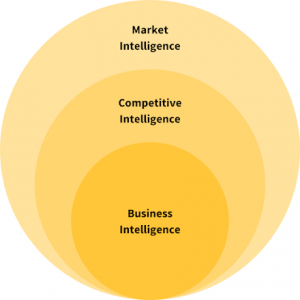
The main goal of Market Intelligence is to outperform competitors by having a valuable and profitable business structure.
Competitive Intelligence
Competitive Intelligence is defining, gathering, analyzing, and distributing intelligence about competitors to make more strategic decisions in an organization. It’s focused on the external business environment.
Many companies know what’s happening inside their own business, but they have a hard time understanding what the competitive landscape looks like.
Competitive Intelligence aims to give business owners the information they need to make more strategic decisions and inform their internal processes. It’s about identifying risks and opportunities before they become apparent, making the company more competitive.
It’s an ethical and legal practice, unlike Industrial Espionage, which is spying, bribing, or blackmailing stakeholders into obtaining information.
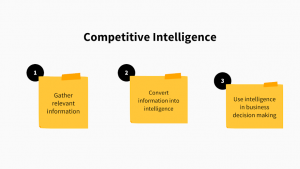
If the information you gather isn’t useful or actionable, it’s not considered intelligence.
To turn information into intelligence, you have to have a clear goal to collect the data relevant to that particular goal. Once you have the data, you need to analyze it and manipulate it.
Start by noticing historical trends based on the data you get.
Business Intelligence
People often use Business Intelligence and Competitive Intelligence interchangeably as business practices that can benefit your business. While this is true, Business Intelligence refers more to internal tactics and Competitive Intelligence with what’s happening outside of your business.
Business Intelligence refers to all the tools and systems that help companies in their strategic planning.
Data Mining
Data Mining is extracting patterns from data, transforming data into information. Data mining is only carried out on samples. This means that samples need to be a good representation of a larger body of data. These samples need to be useful enough to represent the data the samples are collected from.
Finding a pattern in the sample doesn’t mean the pattern is present in the rest of the data, so part of the process of Data Mining is to verify and validate the patterns on other samples of data.
Primary Research
Primary Research is also sometimes referred to as Field Research. It involves collecting data that doesn’t exist yet. If you’ve been interviewed on the phone or on the street, you’ve been part of a Primary Research.
Primary research is challenging to make because it might get expensive and time-consuming. By the time you end the study, the information may be already out of date.
Secondary Research
People also call it Desk Research. In this type of research, you get information from places where it already exists. This can be information that’s already on websites, books, or even public sources of data. Some government agencies make their data publicly available so you can take it and use it for your research.
Marketing Research
Marketing Research shouldn’t be confused with Market Research. Marketing Research is also about gathering information and interpreting it to get insights and making better decisions; the difference is that it’s focused on marketing processes.
There are two ways you can go about doing Marketing Research, in general, by:
- Target or market, by doing Consumer Marketing Research and B2B Marketing Research.
- Methodological approach, by doing Qualitative and Quantitative Marketing Research.
One of the most important ways to leverage Marketing Research is to understand how marketing processes are impacting your customers’ behavior.
Social Marketing Intelligence
Social Marketing Intelligence has become more and more important since social media has become the place where people share almost everything about their lives and the reasons behind their behaviors.
Social Marketing Intelligence is a method of extracting valuable information from social network interactions. Through Social Media Intelligence, companies can identify influencers, audiences, sentiment, and gaps in the market.
Market Research
Doing Market Research is mainly used to know how you gain insights, opinions, and experiences from customers. You can do market research through various techniques like interviews, focus groups, polls, or product/service use research.
Market Research is an organized effort to gather this information and interpret it to get insights and support the decisions you make in your business.
Competitor Analysis
Competitor Analysis is often used as a synonym for Competitive Intelligence, but they’re not the same.
Competitor Analysis aims to identify your current and potential Competitive Landscape strengths, weaknesses, threats, and opportunities.
Competitive Landscape
Your Competitive Landscape is, basically, the companies you compete with. It includes direct, indirect, perceived, and aspirational competitors.
Knowing your Competitive Landscape helps you understand how your competitors might affect your company’s success.
Competitive Matrix
A Competitive Matrix is a great tool because it lets you visualize your competitors and how you compare.
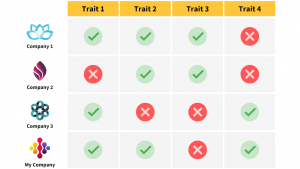
The Competitive Matrix needs to include a list of you and the competition’s core benefits and features.
Competitive Advantage
Your Competitive Advantage is what makes your product or service unique. It’s what adds value to it, and it’s what makes a business sustainable.
It can be a feature, a strategy, or a pricing update that’s hard to copy. Intangible things can also give you a Competitive Advantage, like your ability to innovate or your company’s culture.
Competitive Positioning
Defining how you will differentiate your service or product and make it valuable for the market. Finding where you’ll be in the competitive landscape and deciding how your company will execute to be there.
The most important thing about competitive positioning is defining your value proposition. What’s the unique offering you’ll make to the market?
Competitive positioning is important because it helps you differentiate your value proposition from others, making it easier to get new customers.
Differentiation is what ultimately will help customers to choose you over your competitors.
Predictive Analytics
Predictive Analytics analyzes current and historical facts to make predictions about future events, using techniques like data mining, statistics, and game theory.
You can use it in different ways; one of the most used is to understand customer lifecycles better, for example. Using Predictive Analytics, you can make educated guesses on how acquisition, retention, or sales will work out.
Predictive Analysis helps in assessing potential risks and opportunities. By knowing this, you can plan your strategies better.
Porter's Five Forces Analysis
Porter’s Five Forces is a framework to analyze the competition of a business. Michael E. Porter developed it. This analysis finds out if a market is attractive (a.k.a. profitable) enough by studying five different forces:
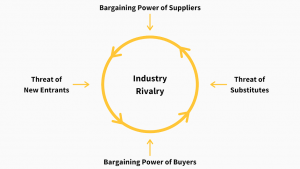
Combining different forces can bring different results, like industries where profitability is low due to high competition, making it unattractive.
A lot of people use Porter’s Five Forces framework in combination with a SWOT analysis.
SWOT Analysis
SWOT stands for Strengths, Weaknesses, Opportunities, and Threats involved in a business venture. The SWOT Analysis is a framework that helps you identify internal and external factors that are favorable or unfavorable to achieving your business goals. Albert Humphrey created it.
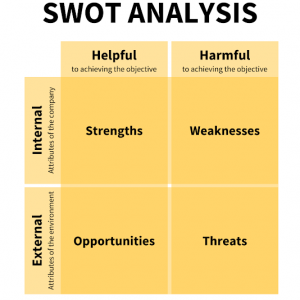
The SWOT Analysis is instrumental in identifying areas of development for a company.
You can also use a SWOT Analysis to understand your competitors!
Start Today!
Using Competitive Intelligence to make better and wiser decisions is something every business (regardless of size) should do. It doesn’t matter if you’re starting or have a company that has existed for years.
Competitive Intelligence can help you develop your idea better, have a more substantial market presence, and launch products that people will want to buy.
Now that you know about all these concepts and, most importantly, what you can get out of using all these tools, it’s time for you to start!


